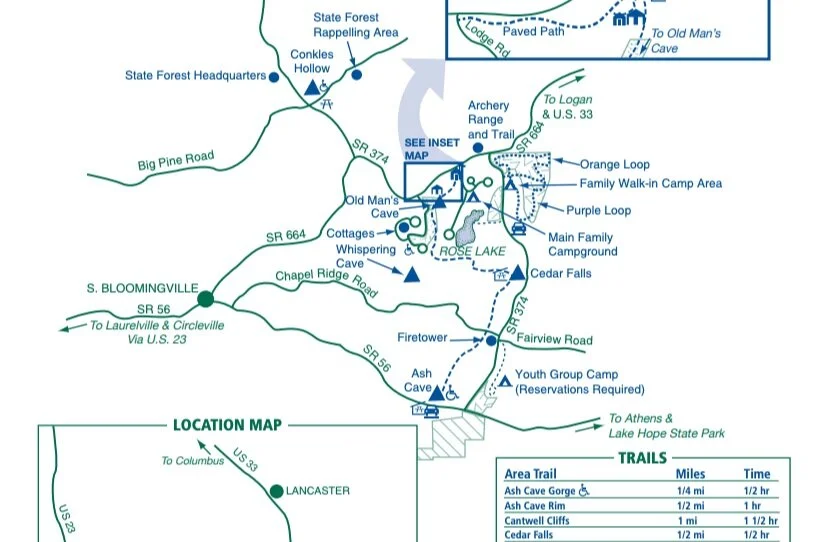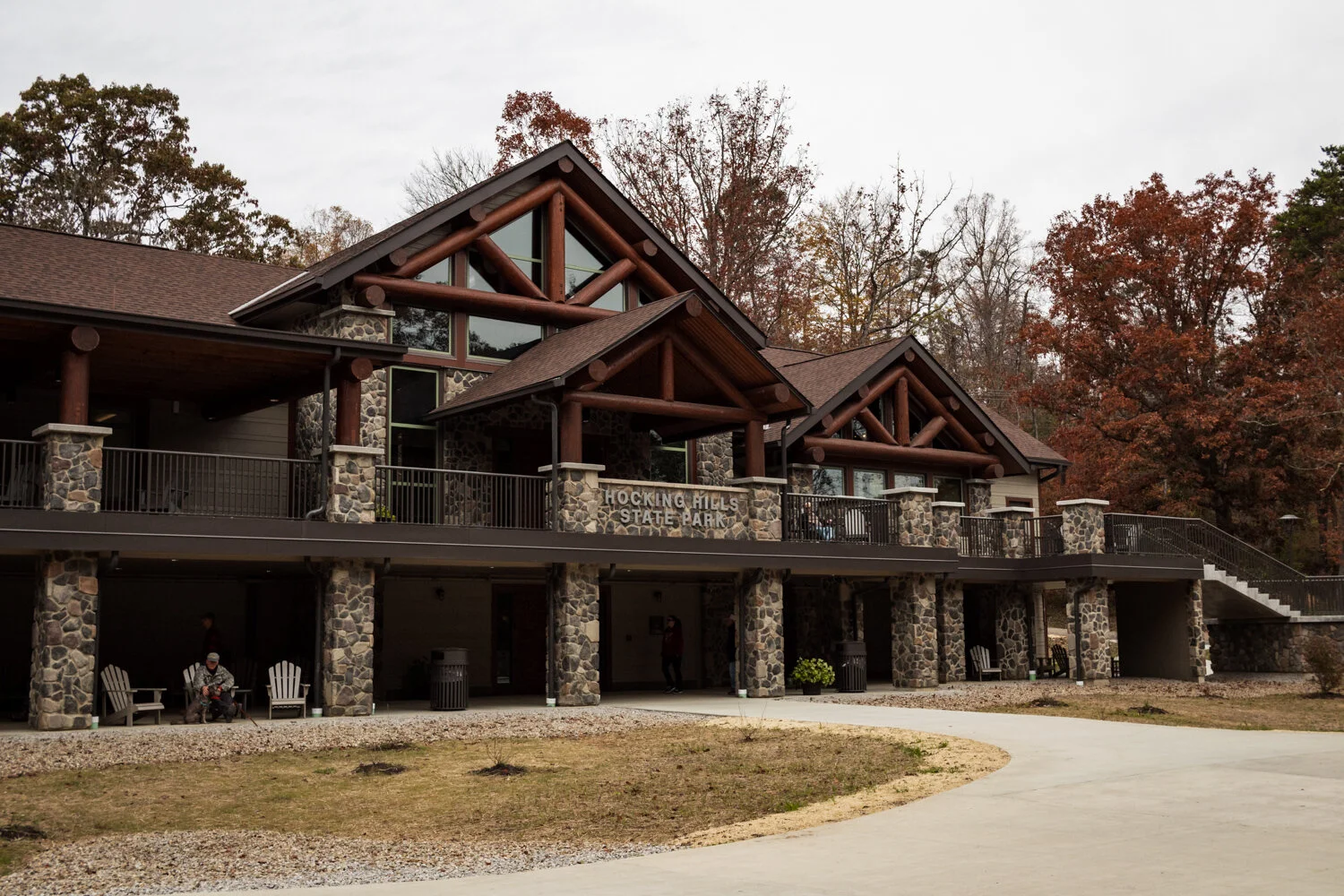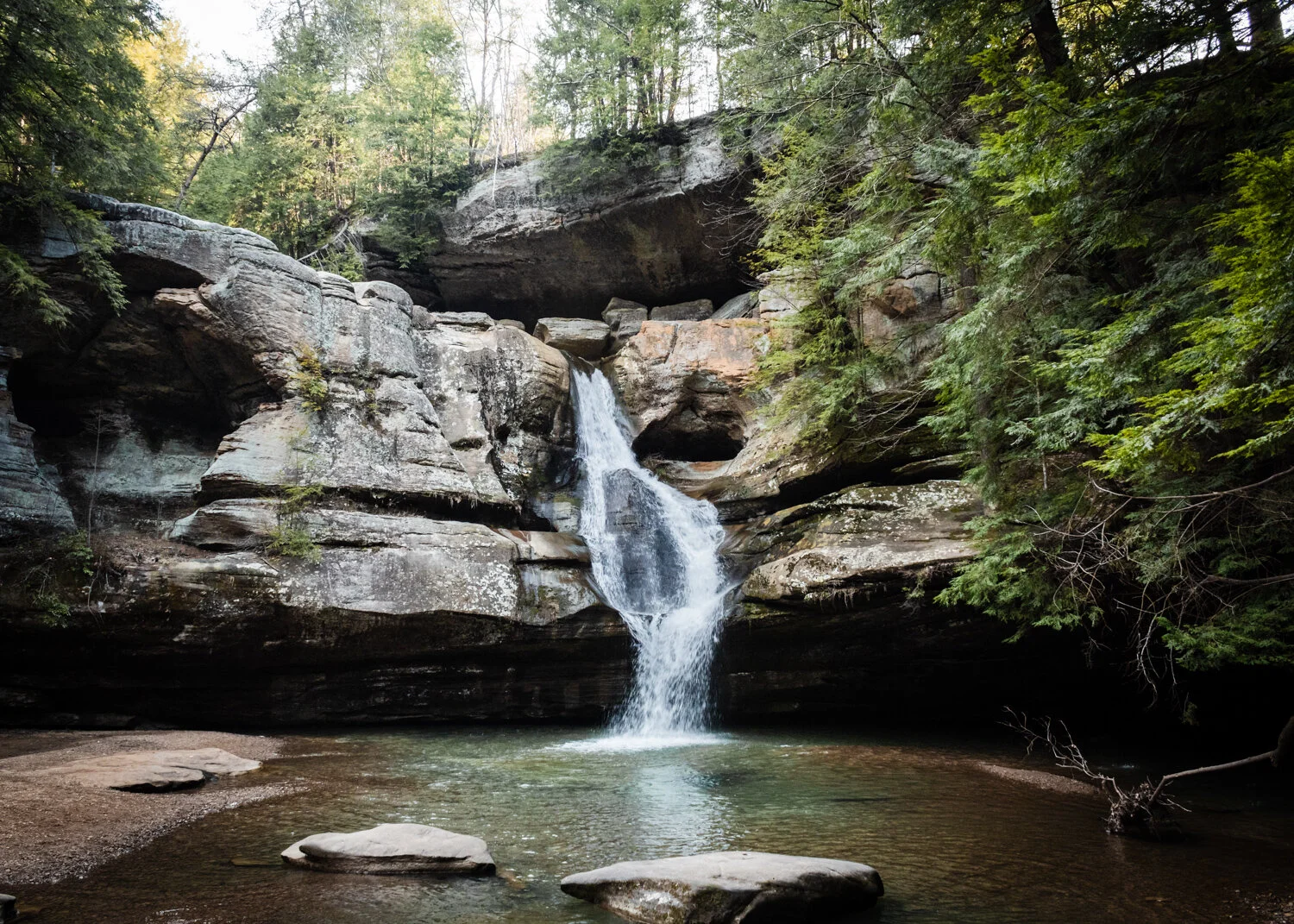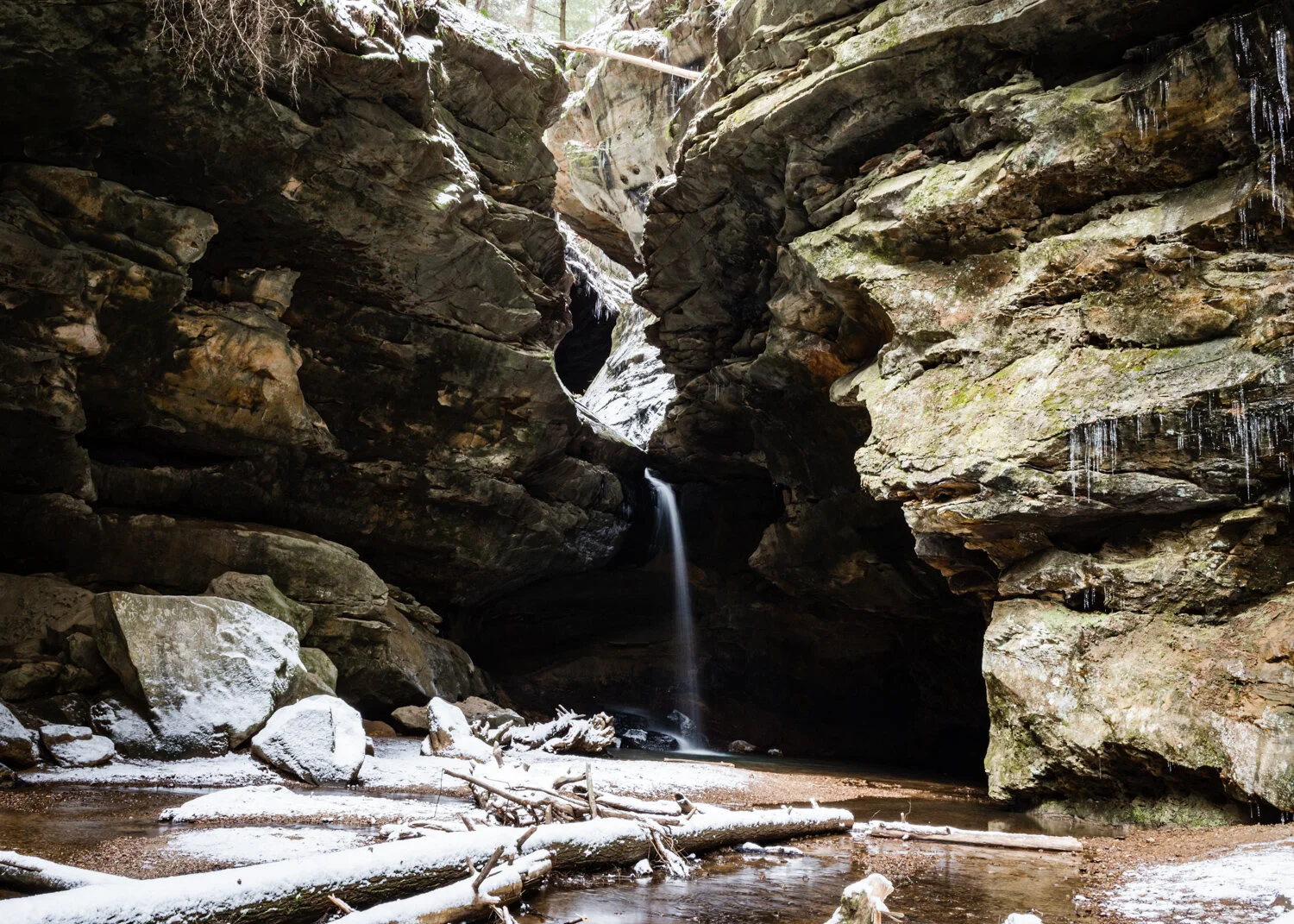The Complete Guide to the Hocking Hills Region
Post Summary: Everything you need to know about visiting the Hocking Hills Region; including where to stay, when to visit, and all the best sites to explore.
Located just over an hour southeast of Ohio’s capital, Columbus, Hocking Hills State Park and the surrounding region, are the crown jewel of the state. Here you’ll find an abundance of waterfalls, towering caves, lakes, a massive forest, stunning trails, and cliff views. Southeastern Ohio is more rural than other parts of the state, what with there being more forests and fewer big cities.
Since as early as 1870, attractions in this region were viewed as scenic, but it wasn’t until 1924 that the state bought and began preserving some of the lands. In 1976, the Ohio Department of Natural Resources was created and took over the park management.
An important thing to note is there is no cell service in and around the park; so you’ll either want to download an offline map or print directions. Many of the trails can be dangerous since they’re so close to cliffs to be extra careful when hiking. Also for the trails, Hocking Hills is especially adamant that you remain on the designated trails to avoid disrupting wildlife and ecosystems, not to mention it can be VERY dangerous to go off many of these trails.
Know Before You Go
When To Visit
As with most places, late spring, summer, and fall are the better seasons to visit unless you like hiking and exploring in the snow. The winter may be beautiful but due to the cliffs and narrow trails and other factors, this place can be dangerous unless properly prepared. Summer is the busiest time here, even during the week, so you’d best be prepared for crowds. I definitely recommend going in the mornings though or later in the evening to avoid crowds, preferably in the late spring when the waterfalls are flowing.
Where To Stay
I recommend staying more than one day in the area so you can fully appreciate the beauty of the region.
Located about 20 minutes north of the park is the city of Logan where you’ll find hotels and other places to stay. Popular Places:
Hocking Hills State Park Campground - Located right next to the Old Man’s Cave area. There’s a campground store, heated showers, full hookup electric sites, as well as primitive campsites.
Explore Hocking Hills shares more campgrounds in the area on their website.
Hocking Hills is known for its stunning cabins and people all over come to stay in many of them. Also, check out Airbnb for even more places. Popular cabins:
Getting Here
Your best bet is to take 71 from Cleveland/Cincinnati or 33 from Columbus. The nearest main airport is John Glen International in Columbus.
Where To Eat
Unless you want to venture outside of the region, you can stop by the Old Man’s Cave General Store for snacks, ice cream, and other supplies. I’d recommend just packing a lunch and snacks to eat at the picnic areas Interesting Facts About Hocking Hills
Interesting Facts About Hocking Hills
Over 330 million years ago, this area used to be covered by the Atlantic Ocean; what you see today is what was carved out and left when the ocean started to recede. Glaciers never reached this part of Ohio, but they still had influence, such as the vegetation.
Evidence shows that man first inhabited the area more than 7,000 years ago.
Many tribes used this land for its resources and called the Hocking River, the Hock-hocking, or bottle river, due to the shape of the river gorge, which is also how the park received its name.
Unlike most of Northeast Ohio, this part of Southern Ohio consists of Black Hand Sandstone. There’s also an abundance of wildlife and plants that are rare and unusual, along with common Ohio sightings.
Every 100 years a massive flood happens in the Hocking Hills; the last time being 1998 when it ripped through the gorges and destroyed man-made structures.
The recess caves you see in the park are made from sapping, where the softer middle layer of the sandstone gets carved out by water and wind. Although these “caves” are not actual caves, they’re just massive overhangs left from the process of sapping.
The Grandma Gatewood trail that runs through the park was named after a famed hiker, Emma Rowena Gatewood, more known for being the first woman to hike the entire Appalachian Trail, not once, but twice. She was in her mid-60’s. But she also was in love with the Hocking Hills region and spent many of her days hiking this 6-mile trail.
Best Things to do in the Hocking Hills Region
With over 10,000 acres of trails, waterfalls, caves, gorges, and more - people from all over come to visit this beauty. The park consists of six main spots - the Old Man’s Cave area, Cedar Falls, Ash Cave, Rock House, Cantwell Cliffs, and Conkle’s Hollow; although there’s plenty more to do outside of these.
Old Man’s Cave Area
The Old Man’s Cave area is one of the most popular spots in the park. It actually consists of more than just the cave, there’s also Upper Falls, Lower Falls, Devil’s Bathtub, and more hidden gems. You begin in the parking lot and head down the trail and right away you’ll find Upper Falls. This is probably the most photographed waterfall in the park with its famous tree stump (not actually famous, it’s just in every picture of the falls and got dubbed the most famous tree stump in Ohio). Upper Falls was an important spot for early settlers since it was the beginning of the gorge and so they built a gristmill at the top.
Head a bit further down and you’ll come across Devil’s Bathtub, an unusual part of the stream where the water swirls and goes straight down. Devil’s Bathtub gets its name from the swirling action that looks like a bathtub, and Devil’s from a legend that says the stream goes down to Hades. Swimming and wading are not allowed in any of the river areas, but be very careful in this spot as it’s near impossible to get out and can be dangerous.
Continue on and you’ll have to go through two different tunnels leading to Old Man’s cave where you can walk through it and view the rest of the gorge from above. The actual Old Man’s Cave further down is the most famous spot in the entire Hocking Hills. The cave gets its name from Richard Lowe, a hermit who lived in the cave with his two hounds.
To get to Lower Falls you have two options, keep going straight instead of going through the cave, or after the cave, you can continue on the trail and down a long tunnel. Either way, you’ll have a lot of steps to get down to the falls. To get back to the parking lot, either go back through the gorge to Upper Falls or go up through the cave and follow the trail and cross the A-Frame bridge to the gorge trail.
>> Related: Hiking The Old Man's Cave Area In Hocking Hills State Park <<
Whispering Cave
Another slightly less-visited spot in the park, probably because it’s “new” to visitors, opening to the public in 2017. Whispering Cave is another large recess cave (300 feet wide) with a small waterfall (150 feet tall), similar to Ash Cave. You can access it either by parking at the Hemlock Bridge trail parking lot (there’s also cabins here) or by hiking from the gorge trail in the Old Man’s Cave area as if you were headed to Cedar Falls. Unlike some of the other caves, there’s a fence to prevent you from falling. The trail itself isn’t too bad, mostly uphill headed there. If you’re coming from the gorge trail, you’ll find yourself at a fork, left for Cedar Falls and right to Whispering Cave, where you’ll cross the park’s only swinging bridge.
Cedar Falls
Another stunning waterfall and gorge in the middle of the park is Cedar Falls. There’s two lots you can park in, a small one that’s a bit closer to the falls or the larger one with the shelter and bathrooms with a short hike down. You’ll pass some hidden gems from either lot, but the actual trail itself is just amazing.
I personally felt this was one of the most beautiful spots in the park. It was such an oasis with the trees surrounding it with that Hocking teal water. The name of this waterfall was actually a mistake from early settlers; they believed the surrounding trees were cedar but they were actually hemlocks, but the name stuck to this day. There used to be a gristmill at the top of the falls in the 1800s. Queer Creek flows over the cliff to give us this stunning waterfall; receiving its name from the unique backward flow of the stream. The trail here was also used by a few tribes, the Shawnee, Wyandot, and Delaware.
Cedar Falls was just recently listed by Insider as one of the 20 Lesser-Known Beautiful Places in the United States.
Ash Cave
Another cave located in the park is Ash Cave; simply hike the fairly short distance from the parking lot and you’ll reach the massive recess; the largest of its kind east of the Mississippi. The cave will tower over you more than the other caves. It has a stunning waterfall in the middle (after a good rainfall) and a very sand-covered ground. Not a very large pool at the bottom of the falls, but it still maintains that Hocking River teal color.
The name comes from early white settlers who found large amounts of ash in the cave, supposedly from the Shawnee tribe campfires or manufactured gunpowder. The white settlers and tribes used the cave for many reasons, including churches and meeting sites.
Ash Cave is also one of the only handicap-accessible trails in the park.
Conkle’s Hollow State Nature Preserve
The 87-acre area of Conkle’s Hollow became a State Nature Preserve in 1977 and while not actually a part of Hocking Hills, it is located just above it and tends to be visited when going to the State Park and shouldn’t be overlooked. Starting at the parking lot, you’ll enter the gorge and watch as it narrows the further you go in (if taking the gorge trail). You’ll find the common eastern hemlock trees and hidden waterfalls after heavy rain.
Steep cliffs make for the more interesting trail for those adventurous souls seeing a thrill. While only 2 miles, the rim trail is narrow and steep and can get close to the edge in some areas, with a stunning overlook at the top. But no worries, the gorge trail below is a short out and back trail where you’ll find the waterfalls and other natural features on the floor, including a small grotto.
Conkle’s Hollow gorge trail is the other handicap accessible trail in the park, to a certain point.
Rock House
Rock House is a part of the park in a separate section, located about 8.5 miles above Old Man’s Cave. This is an area you’ll want to be a bit careful and definitely stay on the trails. The hike down to the house isn’t too bad, a bit steep in some areas but nothing major. But you’ll come close to the edge on most of the trail and definitely when you get to the house, so be careful since there’s no railing to prevent falling.
Rock House itself is astounding, you can actually walk around the inside and see the history and views of the cliffs. You’ll be climbing over some rocks on the outside if you choose to continue on the trail, so watch your footing. While the house is a fairly decent-sized cave to explore, since everyone is in close quarters you’ll want to choose a good time to go because it can get very busy.
As with most of the park, water had eroded the Black Hand Sandstone, creating a cave. What’s special about Rock House is that it’s the only true cave in the park. It’s called Rock “House” because it does actually resemble a house, due to the many support columns, windows, and roof. Many groups have inhabited the cave over the years, including Native Americans, and the cave was a popular tourist attraction long before Hocking Hills State Park was established in 1924.
Cantwell Cliffs
Probably meant for adventure enthusiasts, this rocky area is slightly less visited than the others, partly because it’s further than the other park sites and it’s not for the faint of heart (in my opinion). Similar to other areas, it has a rim and gorge trail, one being more difficult than the other. Here you’ll find small waterfalls and an abundance of Black Hand Sandstone cliffs that the trails will take you up and down (literally, I felt like I was rock climbing on the rim trail).
As for the falls, they’ll need heavy rainfall to be flowing. Cantwell Cliffs is known for its narrow passages, one most notably named “Fat Women’s Squeeze” and other unique geological features. Along the rim trail, you’ll even find a small shelter house for rest near the cliff overlook.
Other Sites to See and Do
Rose Lake
Chapel Cave
Ash Cave Lookout Tower
Rockbridge State Nature Preserve
Hiking in the Hocking Hills
Hiking here is one of the top activities in the state, with all the beautiful sites to see. Some trails are easy, some not. It’s definitely an area that requires you to be aware of your surroundings. With over 10,000 acres, the trails in Hocking Hills provide stunning waterfalls, cliffs, gorges, foliage, and more that showcase just how beautiful Ohio can be.
Popular Trails:
Cedar Falls
Ash Cave
Conkle’s Hollow Gorge & Rim
Upper Falls to Lower Falls
Rock House
Cantwell Cliffs
>> Related: Hocking Hills Region: The Hiking Guide <<
Photography Locations
Unsurprisingly, the park is extremely photographed. This is due to the fact that is one of the only spots in Ohio with this many waterfalls and caves. The best locations to photograph include Ash Cave (after a good rainfall), Lower and Upper Falls, Cedar Falls, and Conkle’s Hollow… although the entire park is worth photographing.
>> Related: Hocking Hills Region: The Photography Guide <<


















